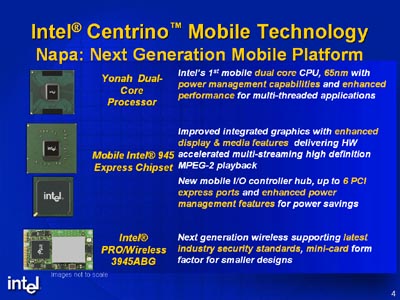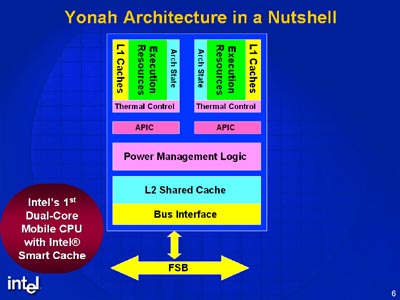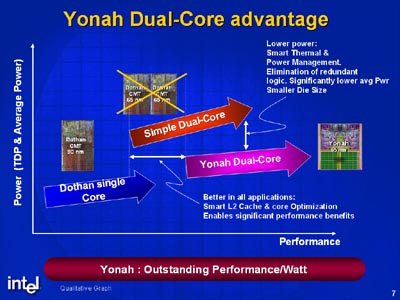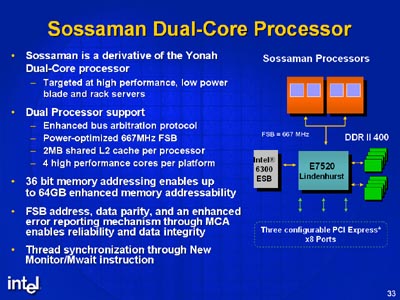While Intel's desktop cores have been looked upon by some as less appealing than AMD's offerings, and a little on the warm side, the same cannot be said for their mobile products. Centrino leaps from strength to strength as a platform and the Pentium M is proving to be quite the mobile workhorse. So, from IDF we have something for the mobile gang: a look at what's in store from the Yonah and Sossaman mobile processors.
Yonah will make an appearance in the next generation of Centrino, codenamed Napa.
In Napa you have Intel's first dual core mobile CPU, Yonah, along with the 945 chipset and 3945abg wireless. The chipset is said to have new multimedia features, along with as many as 6 PCIe ports and of course enhanced power management. The wireless card is a mini-card form factor, which should facilitate smaller mobile solutions (or create room for more hardware features.)
The brief specs for show its new deeper sleep capabilities, 65nm manufacturing process and 2MiB of cache being shared between the two cores.
The two cores within Yonah are identical. Within the CPU is a power management logic unit, and of course the 2MiB of L2 cache previously mentioned. The processor's bus interface is power and performance optimised, and the processor presents itself to the system hardware as a single entity.
Intel sees Yonah as an improvement over what could be obtained from shrinking Dothan to 65nm and slapping two cores together on the same packaging. They say that by removing redundant logic, reducing die size and performing further optimisations, the Yonah dual-core part will be better performing and more power efficient than a simpler dual-core implementation.
One of the big power optimisations that Intel have looked into for Yonah is the cache. They sought to design caches that can run at lower voltage, but they've taken it further than just that. When the cache usage is lower, the amount of cache available is changed both physically and logically. Cache can be powered down the point where there's just enough voltage to retain the data in it, or if empty, powered down even further. This can change dynamically, based on demand. So once the processor gets busy again, the cache is powered back up to full whack.
Moving on from Yonah and onto Sossaman, it's 'brother' if you will. Sossaman is derived from Yonah, but rather than being a mobile solution, it's geared towards Blade servers and dense server racks. Packing in the processing power can product a lot of heat and also consume a lot of power. Sossaman seeks to provide more processing power with increased power saving.
Your platform will have four cores, consisting of two dual-core processors. Each processor has, just like with Yonah, 2MiB of L2 cache to share between the cores. There's 36-bit memory addressing, which equates to 64GB addressable memory. A set of error checking and correcting measures are included to ensure reliability (uptime is your friend.) The bottom line is that Sossaman is a server optimised Yonah.
It's interesting to see how mobile technology can find its way into the rack space too, but when on the move you want long battery life and in a Blade you want low heat output and low power consumption. So, the laptop and the data center have similar interests.

















